15+ Cozy Living Room Ideas for a Warm Atmosphere
A warm living room does two things: it comforts the body and it soothes the mind. After twenty years fitting homes to real life, I know the small choices that make a room feel like a hug. This guide gives you more than fifteen clear ideas. Each one has practical steps, real-world tips, and simple rules so your living room feels cozy every day.
1. Start with layered lighting for gentle warmth

Good light is the backbone of a cozy room. Relying on one bright ceiling light makes a space feel harsh. Instead, use multiple light sources placed at different heights. A soft overhead light sets the mood. A floor lamp near a reading chair gives task light. Table lamps by the sofa add small pools of glow. Dimmer switches help you tune the room from lively day to quiet night. Warm bulbs, not cold blue ones, make colors richer and skin tones softer. Layering light makes the room feel wrapped in warmth and invites people to stay.
2. Choose warm, earthy color tones as your base

Colors set the emotional tone of a room more than any single object. Warm beiges, soft browns, olive greens, and muted terracotta feel friendly and steady. Paint large walls in calm, warm shades so smaller bright accents can shine. If you prefer a bolder look, use deep greens or rich browns on one wall and keep the rest soft. These tones work with many materials—wood, leather, wool—and they age well. Designers keep returning to earthy palettes because they make a home feel grounded and calm.
3. Layer rugs for comfort and sound control
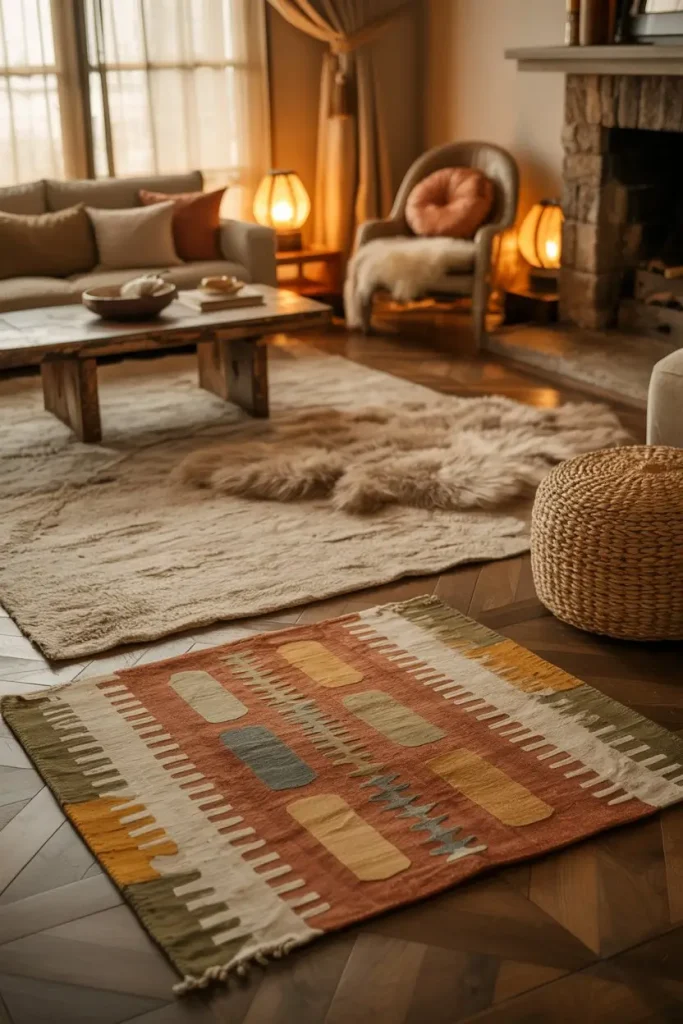
A rug makes the floor feel soft and ties the room together. Use a large rug under the main seating to hold the space. Add a smaller, textured rug near a reading nook or in front of a fireplace to soften steps. Layering rugs—placing one rug over another—adds depth and a lived-in look. Rugs also help with sound, making conversations feel gentle instead of echoing. Choose rugs that are easy to clean for high-traffic areas and consider natural fibers like wool for warmth and durability.
4. Embrace soft textiles and mixed textures

Texture is how a room becomes touchable. Mix smooth fabrics like linen with nubby wools, chunky knits, and soft velvets. Throw blankets over an arm of the sofa, plush cushions in varied sizes, and a knit pouf near the coffee table all invite people to sit and stay. Keep textures in a unified color family for calm, or choose one contrasting texture—like a leather chair with wool throws—to give the room character without chaos. Textiles tell your hands this room is okay to relax in.
5. Arrange seating for conversation, not TV domination
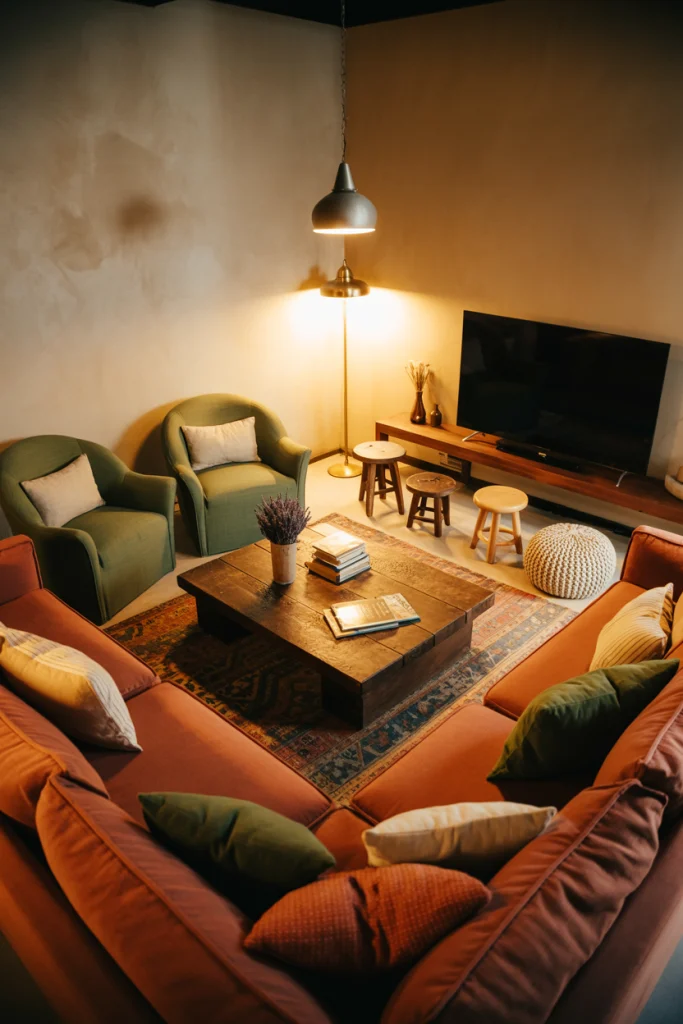
Cozy rooms make it easy to talk. Position sofas and chairs so faces align and people can see each other without shouting. A shallow circle or U-shape around a low coffee table is ideal. If the TV is a feature, place it where it does not dominate the seating layout. Small moveable pieces like stools or poufs let you change the flow when guests arrive. The aim is to create smaller pockets for real conversation and calm togetherness.
6. Add a focal point that soothes—fireplace, art, or a big plant
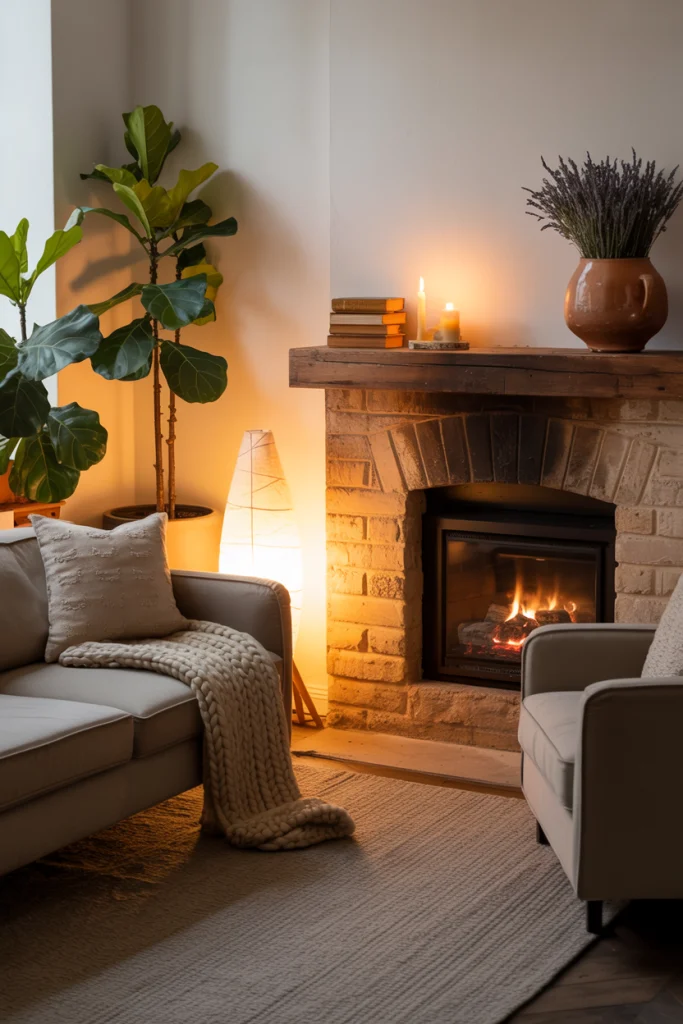
A focal point gives the eyes a place to rest. A fireplace brings real warmth and sound. If you don’t have a fireplace, a large piece of art, a deep green plant, or a textured wall panel can serve the same purpose. Keep the area around the focal point tidy and slightly staged with a small stack of books, a candle, or a meaningful object so it reads as intentional and calm. A steady focal point makes the room feel anchored.
7. Use warm wood and natural materials to add life
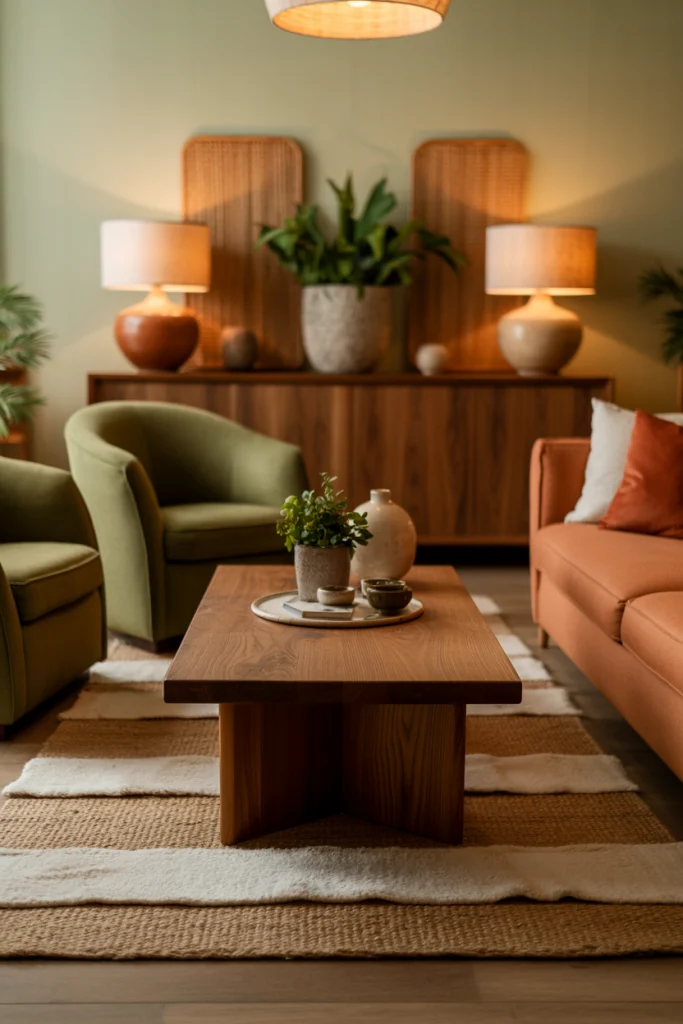
Natural wood tones add instant warmth. A wooden coffee table, sideboard, or open shelving introduces grain and depth that paint alone cannot. Rattan baskets, stone planters, and ceramic lamps bring gentle imperfections that feel human. When you mix woods, keep the undertone similar—warm with warm, cool with cool—to avoid clashing. Natural materials age with softness, not plastic shine, and they invite touch.
8. Keep clutter low but show a few loved things

A cozy room feels personal without being messy. Store small items out of sight in closed cabinets and baskets, and leave a few visible items that mean something—an old vase, a family photo, a stack of favorite books. Rotating displayed items with the seasons keeps the room fresh without changing the whole layout. The goal is a calm surface with echoes of life, not a staged showroom.
9. Layer window treatments for warmth and light control

Windows bring light, but they can also bring drafts and glare. Use layered window treatments to soften light and warm the room. A lightweight linen curtain lets in soft daylight, while a heavier drape can close at night for warmth and privacy. Roman shades give a neat look when needed and tuck away when you want full sun. Layering helps you control mood and temperature with a single pull.
10. Bring in plants for freshness and calm

Plants make a room breathe. A tall ficus or a grouping of small potted herbs near the window adds life and a deep, quiet color. Plants balance the man-made elements and add subtle scent and sound. If care is an issue, choose low-maintenance varieties like snake plant or pothos. Place plants where light fits them and group them at different heights to create a small indoor landscape.
11. Add personal lighting moments: candles and low lamps

Small pools of light create intimacy. Candles—real or high-quality LED—give a warm flutter that no bulb can match. Cluster a few candles on a tray or use one larger pillar by a book. Low lamps on side tables create cozy corners for reading. These small lights are the finishing touch that shifts a room from neat to homey. Always follow safety rules when using open flame.
12. Choose comfortable, deep seating that invites lingering

A cozy sofa is slightly overstuffed and deep enough to curl up on. High, straight-backed furniture often looks neat but can feel formal. If space allows, add a chaise or a deep armchair where someone can put their feet up. Think of fabric choices too: velvet and brushed cotton feel softer to the touch, while leather adds warmth but can be cooler in winter. Comfort encourages presence, which is the heart of coziness.
13. Use scent and sound to set the mood
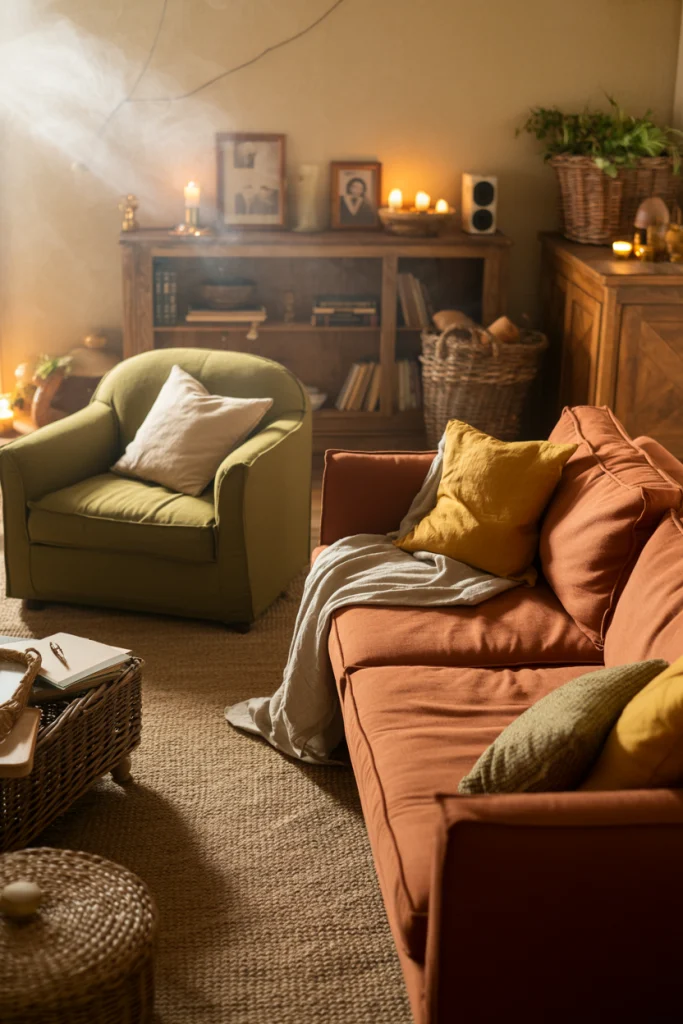
Scent and sound work below words to make a room feel warm. A soft, woody candle or a subtle linen spray can create a memory-anchoring smell. A small speaker playing low-volume acoustic music or a playlist of gentle sounds adds another layer of calm. Avoid strong, overly sweet scents that can tire the senses. Keep sound levels low and textures soft so the room feels like a quiet place to talk or think.
14. Add small, flexible furnishings for function and flow
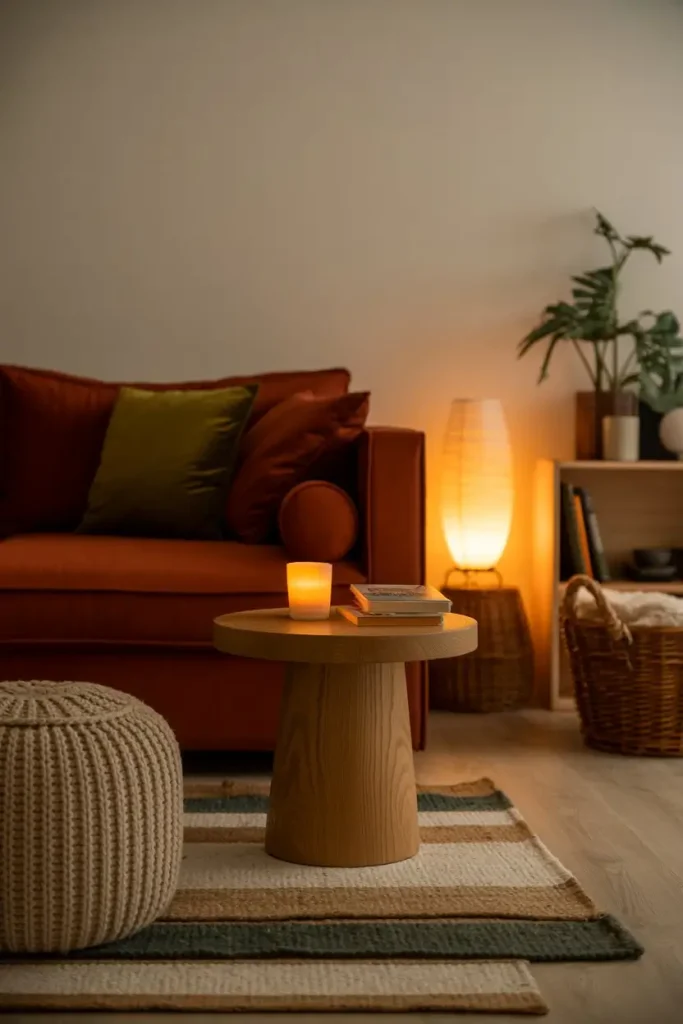
A sturdy side table that moves from spot to spot, a lightweight ottoman that doubles as extra seating, and a small shelf on wheels add flexibility. Cozy homes are lived-in, and flexible furniture makes it easy to change how the room works. Choose pieces that are pleasing to touch and easy to move. These little helpers let you adapt the room for quiet evenings or lively gatherings.
15. Layer art and books to show life and warmth
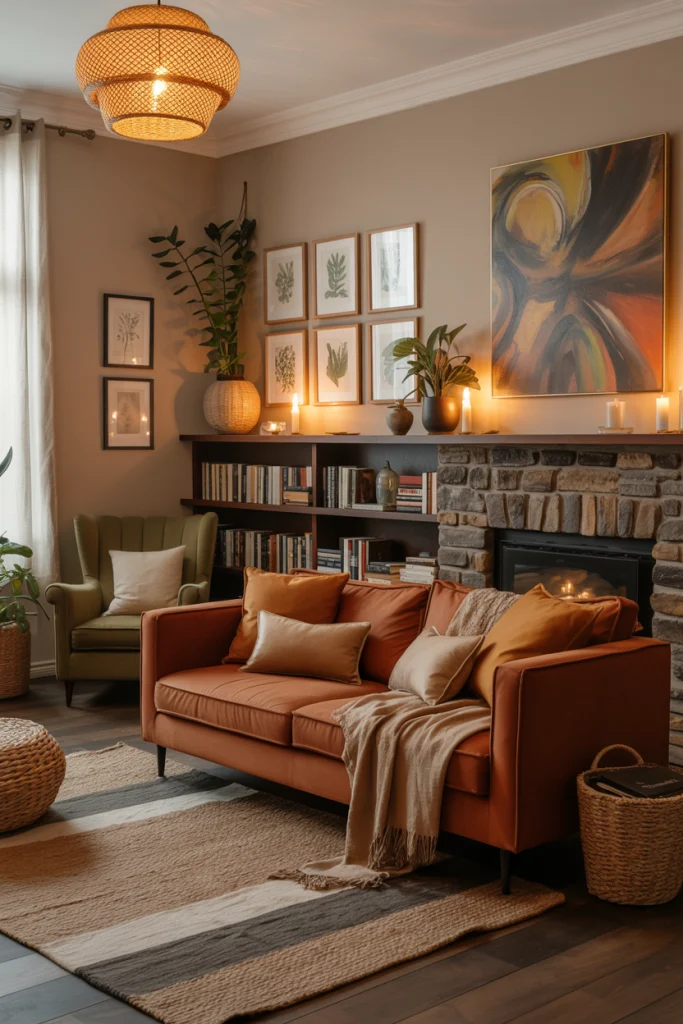
Art and books communicate personality. A small gallery wall with simple frames, a single large painting over the sofa, or a shelf of favorite reads tells the room’s story. Rotate art and books to reflect seasons or moods. Keep frames and cover tones within a small palette to avoid visual noise. When arranged with care, art and books feel like a warm conversation.
16. Plan long-term care: easy cleaning and durable choices

Cozy should not mean fragile. Choose fabrics and finishes you can live with. Slipcovers, washable cushion covers, and rugs that tolerate cleaning keep the room feeling fresh. Pick durable wood finishes and stain-resistant fabrics where kids or pets are present. The long game of cozy is a balance between softness and practicality so the room stays inviting year after year.
17. Small rituals to make the room come alive every day

A cozy room is a practiced habit. Ten minutes each morning to straighten throws, light a candle, or place a fresh plant clipping in a small vase makes the room feel loved. Even small rituals like turning on a lamp at dusk or opening curtains to the morning light teach the space to be welcoming. These simple actions make comfort a daily routine, not a weekend event.
18. Use contrast wisely for visual depth
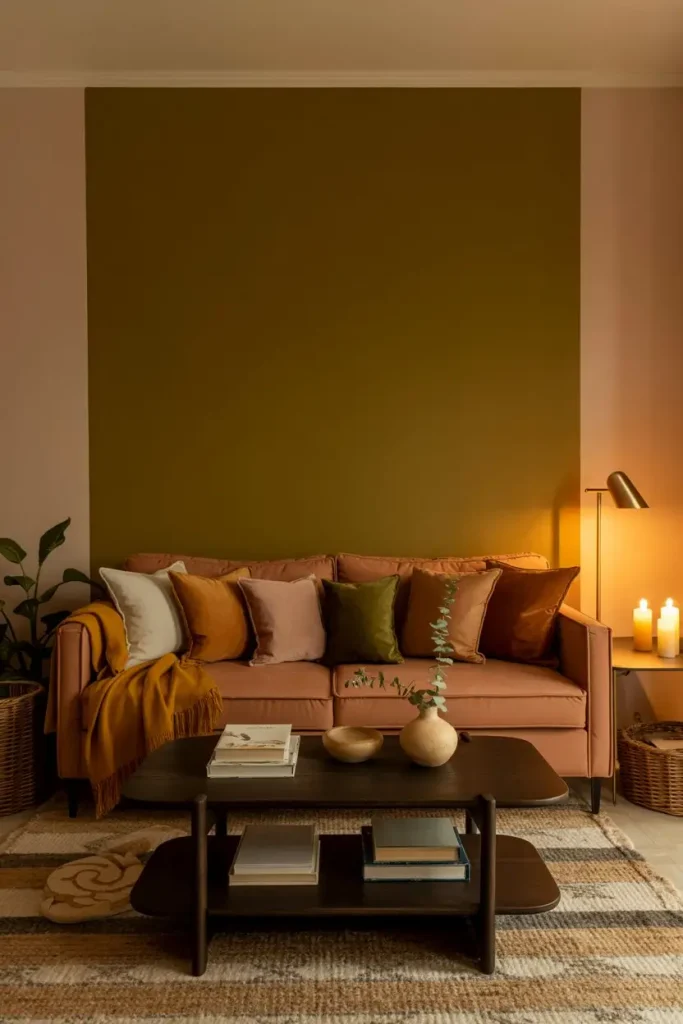
Cozy does not mean one flat color. Use contrast to give the eye places to rest. A deep accent wall, a dark wood table, or a black lamp against soft neutrals adds depth. Keep contrasts in a small family—three or four tones—so the room reads calm. Contrast organizes space and helps the room feel richer without feeling busy.
19. Make the TV feel like part of the room, not the whole room
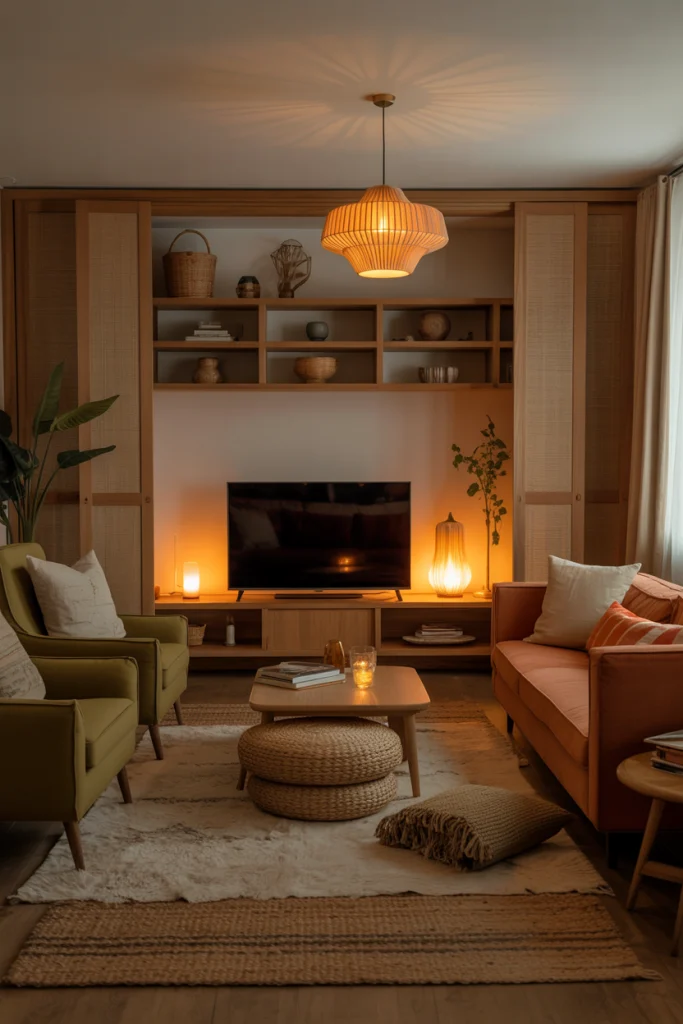
If the TV is present, integrate it so it does not dominate. Put it on a low console with books and art around it, or mount it so it can be hidden behind sliding panels. When the TV is not the focus, the room encourages conversation, reading, and rest. Think of the TV as one element among many, not the only reason the room exists.
20. Seasonal swaps keep the room fresh without big change

Change a few small things each season: a heavier throw in winter, a lighter rug in summer, a new cushion cover for spring. These swaps keep the room feeling new without big expenses. Seasonal change is a quiet refresh that keeps the room aligned with weather and mood.
A cozy living room is a collection of small, sensible choices stacked together. Warm light, layered textures, smart layout, and personal touches do more than one big purchase. They make the room feel lived-in and loved.
If you want, I can tailor these ideas to your exact room size and budget. Tell me your room dimensions, main window locations, and whether you prefer modern, rustic, or classic styles. I’ll make a simple plan you can use right away.






